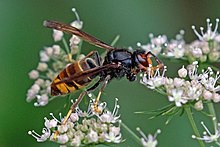Vespa velutina
| Asian predatory wasp | |
|---|---|
 |
|
| Scientific classification | |
| Kingdom: | Animalia |
| Phylum: | Arthropoda |
| Class: | Insecta |
| Order: | Hymenoptera |
| Family: | Vespidae |
| Genus: | Vespa |
| Species: | V. velutina |
| Binomial name | |
|
Vespa velutina Lepeletier, 1836 |
|
The Asian predatory wasp, also known as the Asian hornet or yellow-legged hornet (Vespa velutina), is a species of hornet indigenous to Southeast Asia. It is of concern as an invasive species in some other countries.
Vespa velutina is slightly smaller than the European hornet. Typically queens are 30 mm in length, and males about 24 mm. Workers measure about 20 mm in length. The species has distinctive yellow tarsi (legs). The thorax is a velvety brown or black with a brown abdomen. Each abdominal segment has a narrow posterior yellow border, except for the fourth segment, which is orange. The head is black and the face yellow. Regional forms vary sufficiently in colour to cause difficulties in classification, and several subspecies have been variously identified or rejected. The form that is causing concern about its invasiveness in Europe is Vespa velutina nigrithorax.
Like other hornets, Vespa velutina builds nests that may house colonies of several thousand individuals. Females in the colony are armed with formidable stingers with which they defend their nests and kill their prey. The nest is of paper, roughly in the shape of a huge egg, usually at least half a metre in length. Unlike the nest of the European hornet, Vespa crabro, its exit is usually lateral rather than at the bottom. The nesting season is long, and a colony commonly begins by building a nest in a low shrub, then abandoning it after some months and rapidly building a new one high in a tree, possibly as an anti-parasitic measure. The next generation of young queens disperses in the late autumn to hibernate over winter.
Vespa velutina opportunistically hunts a very wide range of insects, including flies, dragonflies and Orthoptera, typically capturing them by pursuit. The major concern about their invasiveness however, is that when they find a bee colony or an apiary, they tend to settle down and specialise in honeybees as their prey. A hornet occupies a position above a beehive as its hunting territory. It flies about within an area of about half a square metre, scanning the direction from which foraging bees return to the hive. Each hornet vigorously defends its hunting territory, chasing off any rivals. However, as soon as it catches a bee it flies off and another hornet replaces it, usually within a few seconds. The circadian activities of the two species of honeybees are similar, and the hunting hornets match them; their most intense activity is in the morning and afternoon, not near dusk or noon.
...
Wikipedia
